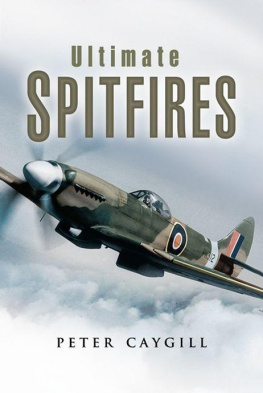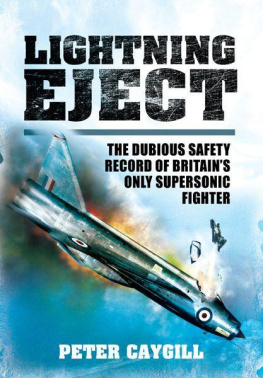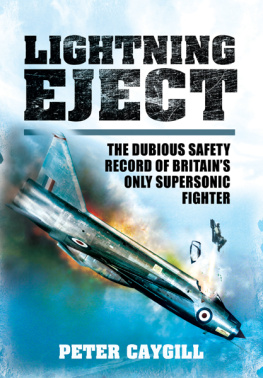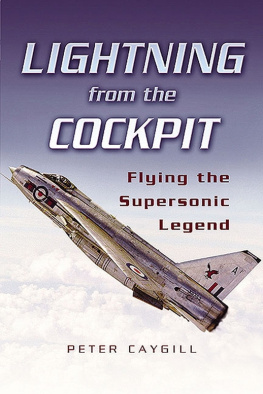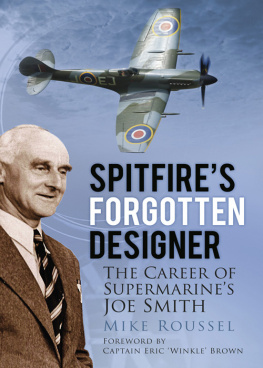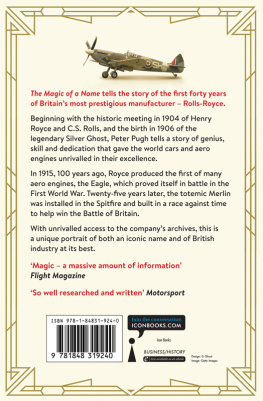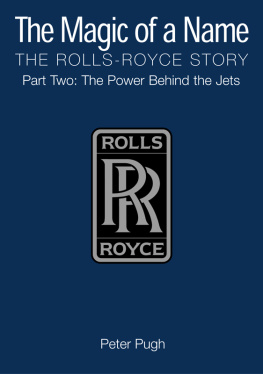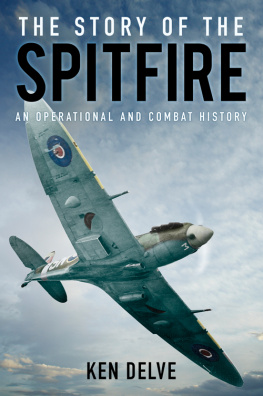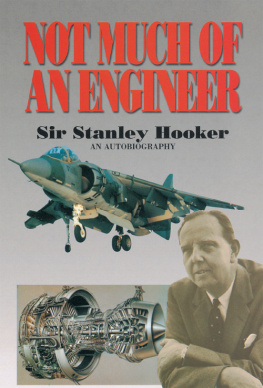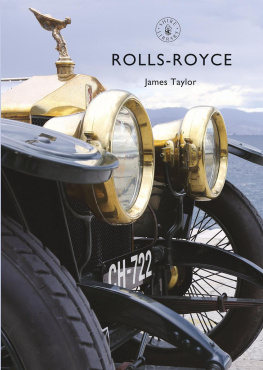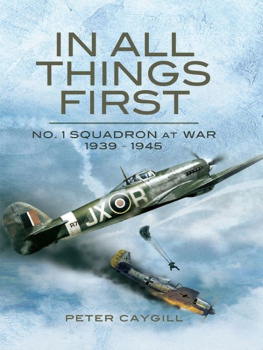
First published in Great Britain in 2006 by
Pen & Sword Aviation
an imprint of
Pen & Sword Books Ltd
47 Church Street
Barnsley
South Yorkshire
S70 2AS
Copyright Peter Caygill, 2006
9781781594360
978 1 84415 416 6
The right of Peter Caygill to be identified as Author of this Work has
been asserted by him in accordance with the Copyright, Designs and
Patents Act 1988.
A CIP catalogue record for this book is
available from the British Library
All rights reserved. No part of this book may be reproduced or transmitted in
any form or by any means, electronic or mechanical including photocopying,
recording or by any information storage and retrieval system, without
permission from the Publisher in writing.
Typeset in Palatino by
Phoenix Typesetting, Auldgirth, Dumfriesshire
Printed and bound in England by
CPI UK
Pen & Sword Books Ltd incorporates the imprints of Pen & Sword Aviation,
Pen & Sword Maritime, Pen & Sword Military, Wharncliffe Local History,
Pen & Sword Select, Pen & Sword Military Classics and Leo Cooper.
For a complete list of Pen & Sword titles please contact
PEN & SWORD BOOKS LIMITED
47 Church Street, Barnsley, South Yorkshire, S70 2AS, England
E-mail: enquiries@pen-and-sword.co.uk
Website: www.pen-and-sword.co.uk
Introduction
When Supermarine Chief Test Pilot J. Mutt Summers took K5054, the prototype Spitfire, on its first flight on 5 March 1936, few who witnessed the event could have envisaged that R.J. Mitchells creation would still be in widespread service ten years later and would continue to perform a useful role until its twenty-first year. At the time the very existence of the Spitfire was uncertain and it was only when it showed speed superiority over the rival Hawker Hurricane (at first there was little to choose between the two) that its future was assured. The fact that Supermarine were able to tweak the propeller to obtain a few more miles per hour was to be of paramount importance not only for Britain, but for the whole of the western world as a Battle of Britain fought without Spitfires may well have resulted in a different outcome.
The decision to persevere with the Spitfire (its early life was also beset by producton difficulties) proved to be inspired as it was recognised at an early stage that the aircraft was capable of considerable development. In contrast, the Hurricane was the culmination of a design stream going back to the classic biplane fighters of the inter-war years and employed tried and tested construction techniques, comprising a tubular metal fuselage and two-spar wing with fabric covering. The Spitfire, on the other hand, featured stressed skin construction throughout and had a very advanced wing which was elliptical in plan and of extremely low thickness/chord ratio. Such an airframe was able to take advantage of the increased power levels offered by developed versions of the Rolls-Royce Merlin engine and the later Griffon with relative ease. This was just as well as the second-generation Hawker Typhoon was to suffer serious engine problems and was to be a complete failure in its intended role as a high altitude fighter.
Although the Spitfire IX with it two-speed, two-stage supercharged Merlin was to be one of the classic fighters of the Second World War, it was felt that an engine of larger capacity was needed if the Spitfire was to continue to compete with advanced versions of the Focke-Wulf Fw 190 and Messerschmitt Bf 109. Use of the Rolls-Royce Griffon, which was developed from the R engine used on the Supermarine S.6B that won the Schneider Trophy for Britain in 1931, gave the Spitfire the increase in power that was needed for it to remain at the forefront of piston-engined fighter technology.
This book looks at the development and flight testing of the Griffon-powered Spitfires and Seafires, together with an operational history both during and after the Second World War. Consideration is also given to the Spiteful and Seafang which were the ultimate developments of the basic Spitfire line and capable of performance levels in excess of the early jet-powered fighters. The last in line was the Seafire F.47 which was capable of a top speed of 453 mph (or around 100 mph faster than K5054) and was cleared for gentle flying at an overloaded weight of 12,900 lbs, or nearly two and a half times the normal take off weight of the first Spitfire. Not surprisingly, with such a prodigious rise in all-up weight, the handling characteristics of some of the later Spitfires/Seafires began to deteriorate, causing adverse comment from the RAFs testing establishments which resulted in a considerable amount of controversy. The problems that were experienced and the solutions that Supermarine came up with are fully explained.
By the end of 1945 jet engines were being developed that were capable of producing around 5,000 lbs thrust and it was clear that the days of the piston-engined fighter were drawing to a close. Had this not been the case, the descendents of the Spitfire, the Spiteful and Seafang may well have played a significant role in the post war RAF and Fleet Air Arm, as performance testing showed that they had extended the boundaries close to the ultimate in terms of what could be achieved by a propeller-driven aircraft. In the event the Spiteful design was to be quietly forgotten but the Griffon-Spitfire lived on and flew its last operational sortie with the RAF on 1 April 1954 in Malaya. The Spitfires last official sortie in RAF colours was conducted by the THUM Flight at Woodvale on 10 June 1957.
PART ONE
Development and Flight Testing
CHAPTER ONE
A Better Spitfire
The Supermarine Spitfire has gone down in history as one of the finest fighter interceptors of all time, its performance and fine handling characteristics, in particular its superb rate of turn, making it a firm favourite with pilots. It also possessed a grace of line that added an aura of glamour and the Spitfires reputation was already well established in the publics perception before it had even entered service. Due to the tireless work of Rolls-Royce in its quest to derive more power from the Merlin engine and the development of better fuels, the Spitfire was able to maintain its pre-eminent position throughout the war and even by 1945 the Spitfire IX/XVI was still the most numerous variant in service.
Despite the undoubted qualities of the Merlin-engined Spitfire, especially the altitude performance of aircraft powered by the two-speed, two-stage supercharged Merlin 61 series, it was obvious quite early in the war that if it was to surpass the likely performance of the new generation of fighters, as typified by the Hawker Typhoon and Focke Wulf Fw 190A, the Spitfire needed to be powered by an engine of much greater capacity. Of all the principal engines of the Second World War, the Merlin, at 27-litres, was one of the smallest. In contrast the Daimler-Benz DB601N which powered the Messerschmitt Bf 109F-1 had a capacity of 33.9 litres, while the BMW 801 fourteen-cylinder radial of the Fw 190A was even larger at 41.8 litres. Whereas other manufacturers tended to favour the use of large, moderately supercharged engines to develop the necessary power, Rolls-Royce chose to utilise their expertise in the field of supercharging to a much higher degree. Even so, there was a limit to the amount of development that the Merlin could withstand and Supermarine and Rolls-Royce began to consider the options for a re-engined Spitfire shortly after the outbreak of war.

